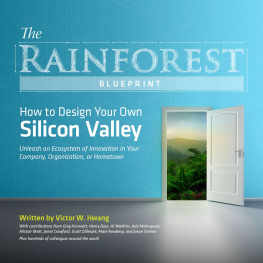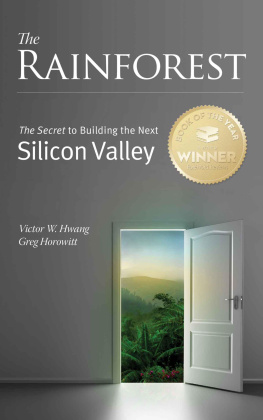
Table of Contents

How to Design Your Own
Silico n Valley
Unleash an Ecosystem of Innovation in Your Company, Organization, or Hometown
Written by Victor W. Hwang
With contributions from Greg Horowitt, Henry Doss, Al Watkins, Ade Mabogunje, Alistair Brett, Janet Crawford, Scott Gillespie, Mark Newberg, and Jason Steiner
Plus hundreds of colleagues around the world
For all mothers, fathers, and spouses who believe in someone they love. Especially mine.
The Author

Victor W. Hwang is a venture capitalist and entrepreneur living in Silicon Valley. His firm, T2 Venture Capital, builds startup companies and the ecosystems that grow them. T2VC leverages the practical know-how of company-building to transform companies, organizations, and communities to become more innovative. The firm has served dozens of clients, such as the World Bank, USAID, and numerous governments and corporations on six continents.
Victor has founded or been involved in the original teams of several startup companies, including Liquidity Corporation (water purification), Veatros (digital search), and Blue Planet Strategies (copper production). He is the former President of Larta Institute, which accelerates the growth of hundreds of startup companies for federal research agencies each year. He practiced law as a corporate attorney on transactions ranging from angel and venture investments to multi-billion dollar corporate mergers and public offerings.
Victor is Executive Director of the Global Innovation Summit, a conference on building innovation ecosystems. He is primary author of the book The Rainforest: The Secret to Building the Next Silicon Valley and a contributing columnist to Forbes .
He received a bachelors degree with honors from Harvard University. He received a law degree from the University of Chicago.

I am of old and young, of the foolish as much as the wise; Regardless of others, ever regardful of others, Maternal as well as paternal, a child as well as a man, Stuffd with the stuff that is coarse, and stuffd with the stuff that is fine; One of the Great Nation, the nation of many nations, the smallest the same, and the largest the same...
Walt Whitman, Leaves of Grass (1900)

Introduction
This book is short. Intentionally so.
Its a simple guide for those who seek to replicate the magic of Silicon Valley in designing their own ecosystems.
Almost everything in this book comes from the other book, The Rainforest. But the other book is 304 pages long, and many of you have asked for something shorter. Like a beginners manual. So we have distilled the information from the other book down to its practical essence. This is not a detailed roadmap, but its a framework to get you started in building your own Rainforest. We plan to publish a more comprehensive Rainforest Handbook soon.
Over the past year, thousands of you have talked with us about the Rainforest. You are launching your own Rainforests all over the world. Watching this happen is humbling.
This Rainforest Blueprint applies to all forms of human organization, whether youre talking about a nascent startup of two, a massive corporation with 100,000 employees, or a city, state, or nation of millions.
The Rainforest model is universal because we are starting from first principles, to ask: what makes human beings tick? From there, we construct an entire model of how human organizations function, and how we can make them more productive. Thus, we connect the micro and the macro.
Decades ago, business guru W. Edwards Deming realized that human connectivity was the key to higher profits, better quality products, and more loyal customers. When we deconstruct what makes Silicon Valley tick, we find Deming. We also find great thinkers like Nobel laureates Ronald Coase (law and economics) and Elinor Ostrom (political economy), E.O. Wilson (sociobiology), AnnaLee Saxenian (regional planning), and Cass Sunstein (law), among many others.
We have deliberately kept this book concise. Thus, we dont address a lot of things. We dont talk much about the underlying scientific research, across many disciplines, that substantiates the Rainforest model. We dont talk much about scaling in a massively parallel way. We dont talk much about quantitative metrics. You can read about some of that in the other book. And we will keep updating our blogs, as we come up with more.
We are still learning. Our ideas are always in draft mode. We revise and improve with each insight, conversation, and revelation. We view this book as a conversation with you, our reader. Visit us on the web at www.t2vc.com, and let us know what you think. How do we make these ideas even better? How do we shift the global paradigm? How do we reinvent the entire way we govern nations, run companies, and manage economies?
This Rainforest movement belongs to you. We are grateful to have you with us, as we transform the way the world conceives value.
Keep remembering to dream, trust, and pay it forward
Victor W. Hwang and the Team at T2 Venture Capital
Selected photos in this book are drawn from our work, including the Global Innovation Summit of July 2012 and various Rainforest-building projects around the world. Learn more at www.t2vc.com and www.innosummit.com
We teach skills and tools to create Rainforests in live design workshops. You can become a certified Rainforest Architect. Sign up at www.rainforest-architects.com
Part I: The Foundation
A short introduction to the foundational structure of innovation ecosystems
Open the door.

This is a short, practical guide for changing the world. Whether youre in a startup, large corporation, university, government agency, investment fund, professional firm, development institution, civic organization, or practically anywhere else.
But unlike other manifestos, this one does not ask you to boil the ocean or move impossible mountains.
In fact, just the opposite.
You can change the world in discrete steps. One person at a time. One action at a time.













